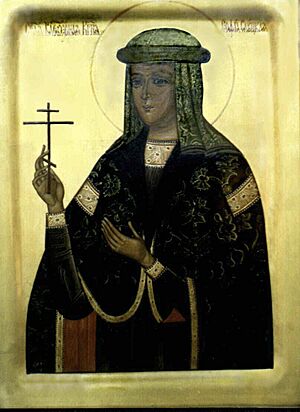Zofia of Słuck facts for kids
Quick facts for kids Saint Zofia of Słuck |
|
|---|---|

Saint Zofia of Słuck
|
|
| Princess of Slutsk | |
| Born | 1 May 1585 Slutsk, Polish–Lithuanian Commonwealth |
| Died | 19 March 1612 (aged 26) Chervyen, Polish–Lithuanian Commonwealth |
| Venerated in | Byzantine Christianity |
| Canonized | 1983 |
| Major shrine | Holy Spirit Cathedral, Minsk |
| Feast | 19 March |
Zofia Radziwiłł (born Olelkowicz), also known as Zofia of Słuck (Lithuanian: Sofija Olelkaitė-Radvilienė; Polish: Zofia Olelkowiczówna, 1 May 1585 – 19 March 1612), was an Orthodox Christian saint from the Polish–Lithuanian Commonwealth. She was the last person in her family line, the Olelkowicz–Słucki princes, who ruled over areas like Slutsk and Kopyl. Her family was related to Prince Algirdas, a famous ruler. Zofia was officially recognized as a saint by the Orthodox Church in 1983. There is a church in Minsk named after her, called the Church of St. Sophia of Slutsk.
Early Life of Zofia
Zofia was born on May 1, 1585. Sadly, her mother, Barbara Kiszka, passed away in the same year. Her father, Prince Jurij Semenowicz Olelkowicz, died a year later, on May 6, 1586. This meant Zofia became an orphan at a very young age.
She was then raised by distant relatives. First, she lived with Jerzy Chodkiewicz, who was a governor in the Samogitia region. He took her to Vilnius. Later, she was raised by Hieronim Chodkiewicz, another governor, in the Brest region.
Her Wedding Story
When Zofia was eleven years old, a marriage was planned for her. This was common for noble families back then. She was to marry Janusz Radziwill, who was a prince and the son of a powerful governor named Krzysztof Radziwill. This marriage was also a way to settle some money matters between the Chodkiewicz and Radziwill families.
The wedding was set for February 6, 1600, in Vilnius. However, before the wedding, the two families had a big disagreement. It was likely about the money and property arrangements for Zofia. The problem even went to court. The court decided in favor of the Radziwills. Some people thought this was because the judge, Jerzy Radziwill, was related to the Radziwill family.
The Chodkiewicz family did not accept the court's decision. They took Zofia to their castle in Vilnius. Janusz Radziwill’s father, Krzysztof, gathered 6,000 soldiers and prepared for a fight against the Chodkiewicz family, who had 2,500 soldiers. It was a very tense situation!
Thankfully, four important senators sent by the Polish King Sigismund III Vasa arrived. They helped the families talk and find a peaceful solution. They agreed that the Radziwills would drop their money claims against the Chodkiewicz family. In return, the Chodkiewicz family was paid for managing Zofia's property.
Zofia's Strong Faith
Janusz Radziwill asked Pope Clement VIII for permission to marry Zofia on July 20, 1600. This was because Zofia was very determined to remain Orthodox and wanted to raise any future children in the Orthodox faith. This led to a discussion between the Pope and the leader of the Orthodox Church, the Patriarch of Constantinople, about marriage between people of different Christian groups.
Around this time, there was a big change called the Union of Brest (1596). This event caused some churches in Belarus and Ukraine to switch from the Orthodox Church to the Holy See in Rome (Catholicism). This was very upsetting for Zofia because she did not want to become Catholic. Most of the noble families in Poland and Lithuania were becoming Catholic, but Janusz, her future husband, was actually a Calvinist at that time.
Zofia and Janusz got married in a church in Brest on October 1, 1600. The wedding followed the Orthodox traditions. Because Zofia was so passionate about her Orthodox beliefs, she played a key role in making sure people in her family's lands (in what is now Belarus) could choose to stay Orthodox instead of becoming Catholic. She also helped pass rules that stopped Catholic priests from replacing Orthodox priests when they passed away.
Zofia was very generous. She gave a lot of money to churches, monasteries, and religious leaders. Thanks to her efforts, Slutsk became a strong center for the Orthodox faith.
Zofia passed away during childbirth on March 19, 1612, at the age of 26. This happened in a place called Myleniec (Omelevo), near the town of Chervyen. She was first buried in the Holy Trinity castle church in Slutsk. Today, her remains are kept in the Holy Spirit Cathedral in Minsk.
Her special day in the Church calendar, called her feast day, is March 19.

